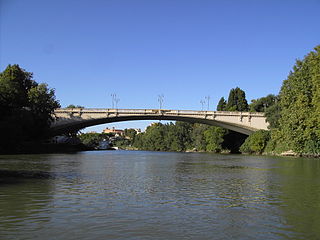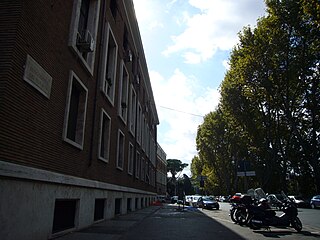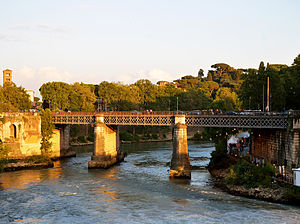Description
The bridge was designed by architect Angelo Vescovali and built between 1886 and 1890 in place of the partially destroyed, 2,200-year-old Pons Aemilius (also called Ponte Rotto, "Broken Bridge"). One arch of the ancient three-arch bridge was destroyed by a flood in 1598, while another arch was demolished by Vescovali in 1887 to make room for the Ponte Palatino, thus leaving the Pons Aemilius just a single arch in mid-river, situated adjacent to the modern bridge.
Ponte Palatino takes its name from the Palatine Hill, at whose slopes the structure rises. The bridge links the Forum Boarium to Piazza Castellani, in front of the Tiber Island; the epithet English is due to the left-hand traffic flow that applies on it, just as in the United Kingdom.
It shows four masonry piers with a metal top surface and is 155 metres (509 ft) long.

Ponte Sant'Angelo, originally the Aelian Bridge or Pons Aelius, is a Roman bridge in Rome, Italy, completed in 134 AD by Roman Emperor Hadrian, to span the Tiber from the city centre to his newly constructed mausoleum, now the towering Castel Sant'Angelo. The bridge is faced with travertine marble and spans the Tiber with five arches, three of which are Roman; it was approached by means of a ramp from the river. The bridge is now solely pedestrian and provides a scenic view of Castel Sant'Angelo. It links the rioni of Ponte, and Borgo, to which the bridge administratively belongs.

The Pons Aemilius is the oldest Roman stone bridge in Rome. Preceded by a wooden version, it was rebuilt in stone in the 2nd century BC. It once spanned the Tiber, connecting the Forum Boarium, the Roman cattle market, on the east with Trastevere on the west. A single arch in mid-river is all that remains today, lending the bridge its name Ponte Rotto.

Ponte Cavour is a bridge in Rome (Italy), connecting Piazza del Porto di Ripetta to Lungotevere dei Mellini, in the Rioni Campo Marzio and Prati.

Lungotevere is an alley or boulevard running along the river Tiber within the city of Rome. The building of the Lungoteveres required the demolition of the former edifices along the river banks and the construction of retaining walls called muraglioni.

Ponte del Risorgimento is a bridge that links Piazzale delle Belle Arti to Piazza Monte Grappa in Rome (Italy), in the Flaminio and Della Vittoria quarters.

Ponte Giacomo Matteotti, formerly Ponte del Littorio, is a bridge that links Lungotevere Arnaldo da Brescia to Piazza delle Cinque Giornate in Rome (Italy), in the Rione Prati and in the Flaminio and Della Vittoria quarters.

Ponte Regina Margherita, also known as Ponte Margherita, is a bridge linking Piazza della Libertà to Lungotevere Arnaldo da Brescia, in the rioni Campo Marzio and Prati in Rome, Italy.

Ponte Umberto I, also known as Ponte Umberto, is a bridge that links Piazza di Ponte Umberto I to Piazza dei Tribunali in Rome (Italy), in the rioni Ponte and Prati.

Lungotevere Gianicolense is the stretch of Lungotevere that links Piazza della Rovere to Ponte Mazzini in Rome (Italy), in the Rione Trastevere.

Via della Lungara is a street that links Via di Porta Settimiana to Piazza della Rovere in Rome (Italy), in the Rione Trastevere.

Ponte Giuseppe Mazzini, also known as Ponte Mazzini, is a bridge that links Lungotevere dei Sangallo to Lungotevere della Farnesina in Rome (Italy), in the Rioni Regola and Trastevere.

Ponte Garibaldi is a bridge that links Lungotevere De' Cenci to Piazza Giuseppe Gioachino Belli in Rome (Italy), in the Rioni Regola and Trastevere.

Lungotevere degli Alberteschi is the stretch of Lungotevere that links Piazza Castellani to Lungotevere degli Anguillara in Rome (Italy, in the Rione Trastevere.

Lungotevere Ripa is the stretch of Lungotevere that links Ponte Palatino to the Port of Ripa Grande in Rome (Italy), in the Rione Trastevere.

Lungotevere Portuense is the stretch of Lungotevere that links Ponte Sublicio to Ponte Testaccio in Rome (Italy), in the Portuense Quarter.

Lungotevere dei Pierleoni is the stretch of lungotevere which links piazza di Monte Savello to ponte Palatino, in Rome, in rione Ripa.

Lungotevere Aventino is the part of the lungotevere connecting the ponte Palatino to Piazza dell'Emporio, in Rome, in the rione Ripa.

The following outline is provided as an overview of and topical guide to Rome:

The Fontana or Fontanone di Ponte Sisto, once known as the Fontanone dei Cento Preti, is an early 17th-century, monumental fountain now located in Piazza Trilussa, facing the south end of the Ponte Sisto, in Trastevere, Rome, Italy. It was reconstructed here in the late 19th century, originally erected across the river, attached to the former building of the Collegio Ecclesiastico.
This page is based on this
Wikipedia article Text is available under the
CC BY-SA 4.0 license; additional terms may apply.
Images, videos and audio are available under their respective licenses.




















